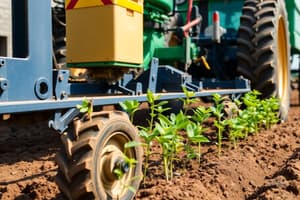Podcast
Questions and Answers
What are the three best practices for soil management?
What are the three best practices for soil management?
Crop rotation, organic matter management, soil conservation
How does crop rotation benefit soil management?
How does crop rotation benefit soil management?
Maintains soil fertility and reduces the risk of pests and diseases.
What is the purpose of organic matter management in soil?
What is the purpose of organic matter management in soil?
To improve soil structure, water-holding capacity, and nutrient availability.
Name one technique used in soil conservation.
Name one technique used in soil conservation.
How does agricultural machinery contribute to modern farming?
How does agricultural machinery contribute to modern farming?
What is one example of agricultural machinery?
What is one example of agricultural machinery?
What is the purpose of irrigation equipment in agriculture?
What is the purpose of irrigation equipment in agriculture?
Explain the difference between subsistence farming and commercial farming.
Explain the difference between subsistence farming and commercial farming.
What is organic farming and what does it avoid?
What is organic farming and what does it avoid?
Describe the process of conservation tillage in crop production.
Describe the process of conservation tillage in crop production.
What is Integrated Pest Management (IPM) and how does it work?
What is Integrated Pest Management (IPM) and how does it work?
Explain the concept of permaculture in agriculture.
Explain the concept of permaculture in agriculture.
Flashcards are hidden until you start studying
Study Notes
Agriculture: A Comprehensive Overview
At the heart of feeding a growing global population lies agriculture, a complex and multifaceted field that encompasses various aspects to ensure a sustainable and productive food supply. In this article, we'll explore several key subtopics, including soil management, agricultural machinery, types of agriculture, crop production, and pest control.
Soil Management
Soil is the foundation of agriculture, providing the physical, chemical, and biological support for plant growth. Effective soil management demands an understanding of soil fertility, structure, and composition. Best practices for soil management include:
- Crop rotation: Planting different crops in the same area in a systematic sequence to maintain soil fertility and reduce the risk of pests and diseases.
- Organic matter management: Enriching soil with organic matter, such as compost and manure, to improve its structure, water-holding capacity, and nutrient availability.
- Soil conservation: Reducing soil erosion, preserving soil structure, and preventing water runoff through techniques such as cover crops, contour farming, and terracing.
Agricultural Machinery
Agricultural machinery is an essential tool in modern farming, helping to increase productivity, efficiency, and adaptability. Some examples of agricultural machinery include:
- Tractors: Powering various implements and providing mobility for farmers.
- Combine harvesters: Harvesting grains by threshing, cleaning, and separating the grain from the chaff.
- Planting and seeding equipment: Sowing seeds accurately and efficiently.
- Irrigation equipment: Delivering water to crops in a controlled manner.
- Sprayers: Applying fertilizers, pesticides, and other chemicals to crops.
Types of Agriculture
Agriculture can be broadly categorized into different types based on various criteria, including the type of crops grown, the farming system, and the resources used. Some examples include:
- Subsistence farming: A small-scale farming system that produces food for a farmer's family and/or community.
- Commercial farming: An intensive farming system that focuses on maximizing profits, often through the use of high-yielding crop varieties and advanced technology.
- Organic farming: A method of farming that avoids the use of synthetic pesticides, bioengineered genes (GMOs), petroleum-based fertilizers, and sewage sludge-based fertilizers.
- Permaculture: A sustainable land management system that focuses on conserving resources, maintaining soil fertility, and promoting diversified plant and animal systems.
Crop Production
Crops are the backbone of agriculture and a primary source of food, feed, and fiber. Crop production involves various steps, including planting, nurturing, and harvesting. To ensure a successful yield, farmers need to consider factors such as climate, soil type, water availability, and pest pressure. Some common methods in crop production include:
- Direct sowing: Sowing seeds directly into the soil.
- Transplanting: Growing seedlings in a nursery before transplanting them into the field.
- Intercropping: Growing two or more crops simultaneously in the same field.
- Conservation tillage: Reducing soil disturbance through techniques such as no-till and reduced-till farming.
Pest Control
Pests, including insects, diseases, weeds, and rodents, can significantly reduce crop yields and quality. A well-designed pest management strategy is essential to minimize damage and maintain crop productivity. Some common approaches to pest control include:
- Integrated Pest Management (IPM): Combining various control methods to minimize pest populations while reducing the use of pesticides.
- Biological control: Using natural enemies such as predators, parasites, and pathogens to control pest populations.
- Cultural control: Modifying farming practices to reduce pest damage, such as crop rotation, intercropping, and crop sanitation.
- Mechanical control: Using physical methods to control pest populations, such as traps, barriers, and cultivation.
- Chemical control: Using pesticides to control pest populations, but only when necessary and in responsible ways.
Agriculture, while facing numerous challenges, is an ever-evolving field that requires ongoing innovation, dedication, and collaboration to ensure a sustainable, secure, and nutritious food supply for the world. Understanding the basics of agriculture and its subtopics is a vital first step to appreciating the complexities and opportunities in this dynamic sector.
Studying That Suits You
Use AI to generate personalized quizzes and flashcards to suit your learning preferences.




